As the school year ends, it is time to encourage students to include regular visits to their local libraries (and perhaps sign up for a summer reading program) over summer vacation. In this week’s column, we review recently published books, as well as some old favorites, for lazy days of summer reading.
Ages 4–8
And Then Comes Summer. Tom Brenner. Ill. Jaime Kim. 2017. Candlewick.
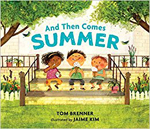 In a series of reflections, a young boy considers the endless joys of summer. The smells, sounds, sights, and activities of summer are presented in lyrical text and cheery acrylic illustrations featuring the boy, his dog, and his friends. The activities the boy enjoys, including selling lemonade, marching in the fourth of July parade, and camping at the lake, will have young children thinking about their own anticipated summer pastimes.
In a series of reflections, a young boy considers the endless joys of summer. The smells, sounds, sights, and activities of summer are presented in lyrical text and cheery acrylic illustrations featuring the boy, his dog, and his friends. The activities the boy enjoys, including selling lemonade, marching in the fourth of July parade, and camping at the lake, will have young children thinking about their own anticipated summer pastimes.
—CA
The Jolley-Rogers and the Monster’s Gold (The Jolley Rogers #3). Jonny Duddle. 2017. Templar/Candlewick.
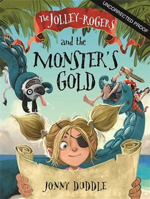 Matilda rejoins the Jolley-Rogers on another buccaneer adventure after finding a bottle with a treasure map inside. They set sail for the mysterious island, singing foreboding treasure hunting shanties. Mayhem erupts when Grandpa’s peg leg is stolen by a menacing sea monster, and their ship soon ends up at the not-so-deserted Banana Island with monkeys, a grizzly old pirate, and Banana Bill (a baker extraordinaire). When the Jolley-Rogers leave Matilda safely behind on the island and set out to find the sea monster, they find themselves in great peril. It’s up to Matilda to save the day with a plan—which may or may not include 99 retired old pirates and a boatload of bananas and gold pieces! Clever, black-and-white digital illustrations contribute to this great read-aloud for young swashbucklers.
Matilda rejoins the Jolley-Rogers on another buccaneer adventure after finding a bottle with a treasure map inside. They set sail for the mysterious island, singing foreboding treasure hunting shanties. Mayhem erupts when Grandpa’s peg leg is stolen by a menacing sea monster, and their ship soon ends up at the not-so-deserted Banana Island with monkeys, a grizzly old pirate, and Banana Bill (a baker extraordinaire). When the Jolley-Rogers leave Matilda safely behind on the island and set out to find the sea monster, they find themselves in great peril. It’s up to Matilda to save the day with a plan—which may or may not include 99 retired old pirates and a boatload of bananas and gold pieces! Clever, black-and-white digital illustrations contribute to this great read-aloud for young swashbucklers.
—NB
Little Pig Saves the Ship. David Hyde Costello. 2017. Charlesbridge.
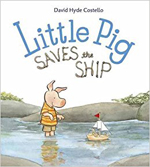 Little Pig is too young to join his older siblings for a week at sailing camp, and must stay behind with Grandpa and Poppy. A book of sailors’ knots and a piece of rope from his oldest brother hold his interest until, one night, Poppy shows Little Pig a toy sailboat he’s building. The next day, Little Pig sews the sails and Poppy carves small figures to “man” the ship. They sail the ship every day until disaster strikes and Little Pig must put his rope-knotting skills to work. Ink-and-watercolor cartoon illustrations with speech balloons add to the fun of this charming adventure.
Little Pig is too young to join his older siblings for a week at sailing camp, and must stay behind with Grandpa and Poppy. A book of sailors’ knots and a piece of rope from his oldest brother hold his interest until, one night, Poppy shows Little Pig a toy sailboat he’s building. The next day, Little Pig sews the sails and Poppy carves small figures to “man” the ship. They sail the ship every day until disaster strikes and Little Pig must put his rope-knotting skills to work. Ink-and-watercolor cartoon illustrations with speech balloons add to the fun of this charming adventure.
—CA
That’s What Friends Are For. Suzanne Chiew. Ill. Caroline Pedler. 2017. Tiger Tales.
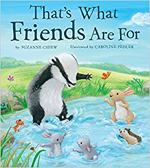 Badger and his friends enjoy splashing in a stream under the summer sun. When Mouse reports that the stream has slowed to a trickle, they all worry—will they have enough water to drink, swim, do laundry, and keep the flowers alive? Trekking upstream, they discover boulders blocking the stream and work together to move them. Colorful, detailed illustrations bring the community of clever critters to life in this gentle lesson on problem-solving and teamwork.
Badger and his friends enjoy splashing in a stream under the summer sun. When Mouse reports that the stream has slowed to a trickle, they all worry—will they have enough water to drink, swim, do laundry, and keep the flowers alive? Trekking upstream, they discover boulders blocking the stream and work together to move them. Colorful, detailed illustrations bring the community of clever critters to life in this gentle lesson on problem-solving and teamwork.
—NB
There Might Be Lobsters. Carolyn Crimi. Ill. Laurel Molk. 2017. Candlewick.
 Eleanor can’t coax her small dog, Sukie, from the stairs leading to the beach. Sukie has a list of reasons to avoid the beach, ending with “and, besides, there might be lobsters.” Eleanor carries Sukie and her stuffed toy monkey, Chunka Munka, down to the sand, and Sukie’s list of fears grows as she gets closer to the water. When Chunka Munka is washed out by the tide, however, Sukie puts aside her fears—including the possibility of encountering lobsters in the ocean—to rescue him.
Eleanor can’t coax her small dog, Sukie, from the stairs leading to the beach. Sukie has a list of reasons to avoid the beach, ending with “and, besides, there might be lobsters.” Eleanor carries Sukie and her stuffed toy monkey, Chunka Munka, down to the sand, and Sukie’s list of fears grows as she gets closer to the water. When Chunka Munka is washed out by the tide, however, Sukie puts aside her fears—including the possibility of encountering lobsters in the ocean—to rescue him.
—CA
Ages 9–11
Blueberry Pancakes Forever (Finding Serendipity #3). Angelica Banks. 2017. Henry Holt.
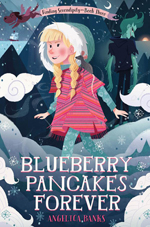 In the final book of the trilogy, Serendipity Smith (the author of the popular Vivienne Small series) is stuck in a period of year-long grief (and writer’s block) after the death of her husband. Serendipity arranges for her friend Colette to watch over her daughter, young Tuesday McGillycuddy, so she can return to the Land of Story to heal and begin writing again. When a villain from her mother’s book kidnaps her friend Vivienne, Tuesday is swept into the Land of Story. She must dig deep inside herself to write her way out of this dangerous plot and back into a life filled with love, good memories of her father’s blueberry pancakes, and new stories.
In the final book of the trilogy, Serendipity Smith (the author of the popular Vivienne Small series) is stuck in a period of year-long grief (and writer’s block) after the death of her husband. Serendipity arranges for her friend Colette to watch over her daughter, young Tuesday McGillycuddy, so she can return to the Land of Story to heal and begin writing again. When a villain from her mother’s book kidnaps her friend Vivienne, Tuesday is swept into the Land of Story. She must dig deep inside herself to write her way out of this dangerous plot and back into a life filled with love, good memories of her father’s blueberry pancakes, and new stories.
—NB
Effie Starr Zook Has One More Question. Martha Freeman. 2017. Paula Wiseman/Simon & Schuster.
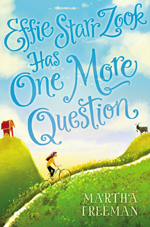 Effie Starr Zook, an 11-year-old girl from a “well fixed” New York City family (thanks to Effie’s great grandfather, the inventor of the barf bag) is spending the summer with her aunt and uncle at Zook Farm in Pennsylvania while her parents tour the world on a test flight of a solar airplane. Expecting to be bored, she’s pleased to meet Moriah Yoder, whose family lives on the edge of the property. She quickly learns there’s “bad blood” between the Zooks and the Yoders. Effie, a pro at asking questions, wants answers but gets none from her evasive relatives. The more she learns about her famous great grandfather, Mr. Yoder (the founder of the Beards of America movement), and Mr. Odbody (a bookstore owner and the only African American in town), the more questions she has. Uncovering family secrets will keep Effie busy for the summer.
Effie Starr Zook, an 11-year-old girl from a “well fixed” New York City family (thanks to Effie’s great grandfather, the inventor of the barf bag) is spending the summer with her aunt and uncle at Zook Farm in Pennsylvania while her parents tour the world on a test flight of a solar airplane. Expecting to be bored, she’s pleased to meet Moriah Yoder, whose family lives on the edge of the property. She quickly learns there’s “bad blood” between the Zooks and the Yoders. Effie, a pro at asking questions, wants answers but gets none from her evasive relatives. The more she learns about her famous great grandfather, Mr. Yoder (the founder of the Beards of America movement), and Mr. Odbody (a bookstore owner and the only African American in town), the more questions she has. Uncovering family secrets will keep Effie busy for the summer.
—CA
Tricked (Fairy Tale Reform School #3). Jen Calonita. 2017. Sourcebooks Jabberwocky/Sourcebooks.
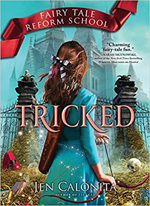 Gilly Cobbler, former Fairy Tale Reform School (FTRS) student, worries that her younger sister, Anna—who was sent to FTRS for blowing up Red’s shop with her friends Hansel and Gretel— is in danger. The evil Rumpelstiltskin (Mr. Stilts), now in charge of FTRS, has a new school motto: If you can’t become a better person, become a better villain. Before Gilly can get Anna out of the school, she’ll have to get herself thrown back in. In this magical mashup of mermaids, fairies, pirates, and princesses, as Gilly and her crew work to banish Mr. Stilts, they learn that it’s not just important to be good, but to discover what they are good at.
Gilly Cobbler, former Fairy Tale Reform School (FTRS) student, worries that her younger sister, Anna—who was sent to FTRS for blowing up Red’s shop with her friends Hansel and Gretel— is in danger. The evil Rumpelstiltskin (Mr. Stilts), now in charge of FTRS, has a new school motto: If you can’t become a better person, become a better villain. Before Gilly can get Anna out of the school, she’ll have to get herself thrown back in. In this magical mashup of mermaids, fairies, pirates, and princesses, as Gilly and her crew work to banish Mr. Stilts, they learn that it’s not just important to be good, but to discover what they are good at.
—NB
Ages 12–14
The Harlem Charade. Natasha Tarpley. 2017. Scholastic.
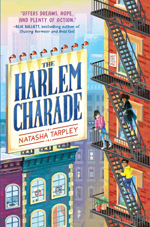 Seventh graders Jin, Elvin, and Alex are researching class project ideas about their Harlem neighborhood when Elvin’s grandfather is mysteriously attacked. Elvin, locked out of the apartment, ends up living on the streets. The three friends work together to learn what happened to Elvin’s grandfather, who is in a coma. When their sleuthing uncovers a politician’s plan to build “Harlem World,” a nefarious money-making scheme that will cause some residents to lose their homes and businesses, they know they must follow the clues, even as they lead them into danger. Notes about the historical context, events, and locations in the book provide a background for this historical mystery.
Seventh graders Jin, Elvin, and Alex are researching class project ideas about their Harlem neighborhood when Elvin’s grandfather is mysteriously attacked. Elvin, locked out of the apartment, ends up living on the streets. The three friends work together to learn what happened to Elvin’s grandfather, who is in a coma. When their sleuthing uncovers a politician’s plan to build “Harlem World,” a nefarious money-making scheme that will cause some residents to lose their homes and businesses, they know they must follow the clues, even as they lead them into danger. Notes about the historical context, events, and locations in the book provide a background for this historical mystery.
—NB
When My Sister Started Kissing. Helen Frost. 2017. Margaret Ferguson/Farrar Straus Giroux.
 Claire and Abigail had always loved spending a month each summer with their father at his cabin at Heartstone Lake. This year everything is different. Their father has remarried, and expecting a baby. And something between Claire and Abigail has changed. Claire is confused over the changes that are playing out this summer. In an endnote for this beautifully crafted novel in verse, Frost explains her use of different poetic forms to give voice to key characters: quatrains for Claire, free verse for Abigail, and acrostics for the Lake.
Claire and Abigail had always loved spending a month each summer with their father at his cabin at Heartstone Lake. This year everything is different. Their father has remarried, and expecting a baby. And something between Claire and Abigail has changed. Claire is confused over the changes that are playing out this summer. In an endnote for this beautifully crafted novel in verse, Frost explains her use of different poetic forms to give voice to key characters: quatrains for Claire, free verse for Abigail, and acrostics for the Lake.
—CA
Ages 15+
Camp So-And-So. Mary McCoy. 2017. Carolrhoda Lab/Lerner.
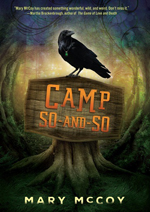 Lured by a glossy brochure, 25 girls find themselves at remote Appalachian Camp So-And-So. Once their parents leave, the girls realize that something’s not right; facilities and activities are not what the brochure promised, and there is a complete lack of adult supervision. The occupants of the cabins will need to ban together to survive challenges specially chosen for each cabin. McCoy weaves the story from cabin to cabin, across five separate plots, with comments from an omniscient narrator and a counselor-in-training. Readers won’t be able to put down this weird and totally absorbing horror story about a very dangerous summer at camp.
Lured by a glossy brochure, 25 girls find themselves at remote Appalachian Camp So-And-So. Once their parents leave, the girls realize that something’s not right; facilities and activities are not what the brochure promised, and there is a complete lack of adult supervision. The occupants of the cabins will need to ban together to survive challenges specially chosen for each cabin. McCoy weaves the story from cabin to cabin, across five separate plots, with comments from an omniscient narrator and a counselor-in-training. Readers won’t be able to put down this weird and totally absorbing horror story about a very dangerous summer at camp.
—CA
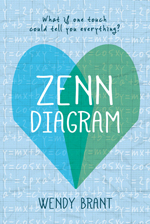 Zenn Diagram. Wendy Brant. 2017. Loft/Kids Can.
Zenn Diagram. Wendy Brant. 2017. Loft/Kids Can.
Reclusive 17-year-old math genius Eva has a special gift. When she touches another person, or anything that belongs to that person, she can instantly read them. This makes her a great math tutor; coaches know that she can be counted on to raise the GPAs of athletes sidelined by poor grades. Because she picks up pain through touch, Eva avoids direct contact with others. She senses an intense emotional “fractal” when she accidentally touches Zenn—a tutee—but as romance blossoms and they embrace, there is no physical agony. Just as Eva decides that it is time to break loose from her self-imposed prison and learn more about life, something happens that cracks her world apart.
—NB
Nancy Brashear is Professor Emeritus of English from Azusa Pacific University, in Azusa, California. Carolyn Angus is former Director of the George G. Stone Center for Children's Books, Claremont Graduate University, in Claremont, California.
These reviews are submitted by members of the International Literacy Association's Children's Literature and Reading Special Interest Group (CL/R SIG) and are published weekly on Literacy Daily.